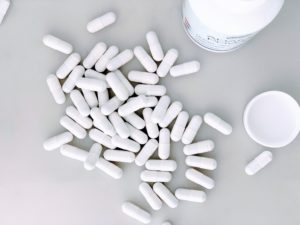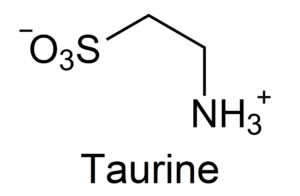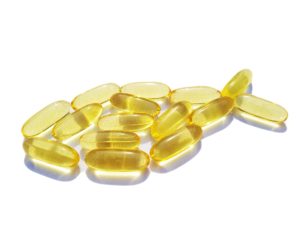The Potential Benefits of Chicory

Chicory (Cichorium intybus) is often considered a weed, commonly growing on roadsides or in pastures. Native to Europe and Asia, the plant was introduced to North America and, like its close relative dandelion, quickly became naturalized throughout the region. Probably the most well known use of chicory is as a coffee substitute, but the plant appears to have additional potential utility. While research is still fairly early, initial evidence suggests possible benefits for the digestive tract and liver, for helping treat diabetes, for decreasing bone loss and for reducing inflammation and arthritis.
Chicory and the Gastrointestinal Tract
Chicory root contains high amounts of inulin, a type of carbohydrate that is indigestible for humans. As inulin passes through the digestive tract, it acts as a prebiotic, a food source for beneficial bacteria. Inulin, derived from chicory, is often sold as a supplement to support digestive function. However, some people may find that inulin produces gas and bloating to an uncomfortable degree and should use inulin with caution or increase dosing slowly over time to minimize side effects (Bonnema 2010). By improving the gastrointestinal flora, chicory inulin may have benefits for digestion.
A study in elderly individuals with constipation found that 15 grams a day of chicory inulin reduced constipation and improved digestion (Marteau 2011). The main side effect was flatulence which wasn’t severe enough for anyone to discontinue treatment. An earlier study also found benefits for increasing stool frequency with “longer-chain” chicory inulin in adults with low-stool frequency or constipation (Hond 2000).
Chicory and the Liver
Non-alcoholic fatty liver disease is the most common form of liver disease affecting around one-quarter of adults worldwide (Younossi 2016). The condition is typically caused by poor diet which contributes to a build up of fat in the liver. Animal studies have shown improvements in fatty liver disease with chicory-seed extract (Ziamajidi 2013). In rats, root extracts have also been shown to significantly reverse the negative liver effects of a high-fat diet. Chicory was even found to help reverse the diet’s effects on weight gain (Wu 2018).
A study in patients with non-alcoholic fatty liver disease found that supplementing ground chicory seed increased antioxidant levels and decreased levels of inflammation. In addition, patients taking chicory seed had a small, but significant weight loss, on average around five pounds over the three-month study (Ghaffari 2019).
Chicory and Diabetes
As an herb, chicory also appears to have promise in helping to treat blood sugar problems and diabetes. One study giving diabetics 10 grams of chicory inulin daily found improved blood sugar, liver function and blood pressure (Farhangi 2016).
A separate study using a water extract of chicory seeds in diabetic patients also found significant benefits. Blood sugar improved, inflammation was reduced and triglycerides, a type of fat that contributes to heart disease, were also lower. The authors recommended chicory seed as a potential adjunct therapy for diabetics (Chandra 2020).
Animal studies also appear to show strong anti-inflammatory effects that inhibit blood sugar problems in mice fed a high-fat diet known to induce diabetes (Shim 2016).
Chicory and Osteoporosis
Steroid medications are known to cause bone loss and increase risks for osteoporosis. A study in rats found that chicory had bone-sparing benefits, decreasing bone loss after the administration of steroids (Hozayen 2016).
A small study in postmenopausal women found that chicory inulin increased bone formation over the course of six weeks of supplementation (Holloway 2007). The study found that women with lower bone mineral density in the lower spine responded better to treatment than those with more normal spinal bone density.
Chicory and Arthritis
Considering how other studies have found anti-inflammatory effects with different forms of chicory, it shouldn’t be too surprising that a study found benefits for arthritis. In a small study of arthritic patients, 90% of the highest-dose group improved at least 20% percent with chicory-root extract supplementation (Olsen 2010).
Different Forms of Chicory

The challenge of using chicory as an herbal treatment can come down to finding the necessary form. Research has explored treatment with chicory seeds, chicory roots and chicory inulin, a specialized root extract. Even chicory inulin can come in different forms, depending on the type of extraction and processing.
In general, inulin supplements are broadly available, as are roasted chicory roots, typically sold as a coffee substitute. Edible chicory seeds and non-roasted roots are more challenging to acquire. If you live in the right place, growing your own chicory, or wild harvesting may be possible, but wild harvesting should only be done if the plants are unsprayed and not near busy roads or highways as they might accumulate heavy metals (Guerin 2022).
Conclusion
Chicory is a prolific plant often growing in large quantities along roadsides or in pastures. While not well-studied, initial research suggests a host of potential uses, from improving or treating constipation, liver function, diabetes, bone loss and arthritis. Hopefully, as more research is done exploring the benefits of chicory, the herb will become more broadly available in all its forms.



